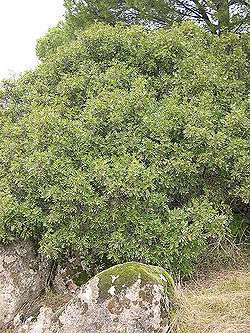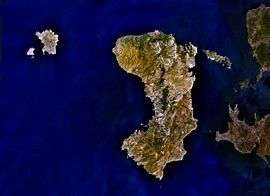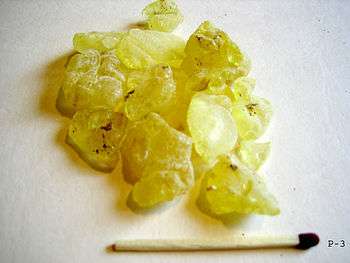Chios Mastiha

Chios Mastiha is a variant of mastic which has a protected designation of origin status in the European Union.[1] The main flavourings used in Chios Mastiha liqueur, mastic distillate and mastic oil, are wholly derived from PDO-certified Chios mastic.[2] Mastic is harvested from the mastic tree (Pistachia lentiscus var. chia), a small evergreen shrub that grows to about two to three meters on rocky terrain on the southern part of the island of Chios. This tree takes fifty years to reach maturity, and can be harvested for mastic from its fifth year onwards. Although the mastic tree can be found around the Mediterranean Sea, the variety that produces the aromatic mastic sap only grows in the southern part of Chios. Chios mastic has also been certified by the Agricultural Products Certification and Supervision Organization as part of the Hellenic Ministry of Rural Development and Food.[3]
Chios Mastiha liqueur is served cold and has a crystal clear colour and a sweet aroma. The ingredients are mastic oil and/or distillate, water, alcohol and sugar.
Mastic is also used for therapeutic purposes, and in cooking and baking.
Producers and distributors
Chios
- The Growers' Spirit is a producing company run by the Chios Gum Mastic Growers Association (CGMGA).[4] The CGMGA offers Mastiha liqueur made with both mastic distillate and mastic oil in two different variants: Kentos (20% alcohol) and Enosis (30% alcohol).
- Stoupakis Chios Distillery produces Homeric Mastiha, which contains mastic distillate.
Wider Greece
- Skinos, based in Athens.
- Finest Roots, based in Kalamata, produces Roots Mastiha.
- Mavrakis, based in Patra.
United States
- Ambrosia Group, based in Miami, produces FOS Greek Mastiha.[5]
- YA Mastiha
History
| Chios (Χίος) | |
|---|---|
 | |
| Country | Greece |
| Administrative region | North Aegean |
| Regional unit | Chios |
| Time zone | EET (UTC+2) |
| • Summer (DST) | EEST (UTC+3) |
| Website | www.chios.gr |
Mastic has been harvested for at least 2,500 years since Greek Antiquity. The first mention of actual mastic 'tears' was by Hippocrates. Hippocrates used mastic for the prevention of digestive problems, colds and as a breath freshener. Roman emperors used mastic along with honey, pepper, and egg in the spiced wine conditum paradoxum. Under the Byzantine Empire, the trade of mastic was made the emperor’s monopoly. In the Ottoman Empire, the sultan gathered the finest mastic crop to send it to his harem.
At present, there are twenty-four Mastic villages on the island of Chios, which have been dedicated to the cultivation and production of mastic since the Byzantine era. These villages are fortress-like, out of sight from the sea, surrounded by high walls and with no doors at street level, meaning that the villages were entered only by ladders) in order to protect the sap from invaders. Although the liqueur is much younger, it is still tied up with Greek history. Digestive liqueurs, similar to Mastiha but made with grapes, were known as the Greek elixirs before the French Revolution.
Harvest

Producing the mastic resin is a whole-year process for the local growers. The harvest is known as kentos and starts in early summer when local growers start clearing the area beneath the trees, and create a chalky protective bed for the sap using a fine white argil, which they carry from a different part of the island. They then make small incisions in the mastic trees' trunks and branches to release the sap. As these clear drops hang from the tree, and sparkle in the sunlight, they are said to resemble crystalline teardrops; for this reason, the mastic sap is known as the “tears of Chios”. It takes about 15–20 days for the first sap crystals to harden and fall to the argil bed. The farmers then wash the tears in natural spring water, and spend most of the winter cleaning and separating the tears from the sand. This cleaning process is performed by hand and is regulated by the legislative framework of the Mastic Growers’ Association.
Mastichochoria

The island's mastic production is controlled by a co-operative of medieval villages, collectively known as the 'Mastichochoria (Μαστιχοχώρια), which is also located in southern Chios. There is a small Museum of Mastic in the village of Pyrgi.
Chios Gum Mastic Growers Association
Founded in 1938, the Chios Gum Mastic Growers Association (Ένωση Μαστιχοπαραγωγών Χίου), abbreviated CGMGA, is a secondary cooperative organisation and acts as the collective representative organ of twenty primary cooperatives founded in the twenty-four mastiha villages (Mastichochoria) of southern Chios. With 4,959 members in 2003[6] , it has the exclusive management of natural Chios Mastiha in Greece and abroad.[7] Its international equivalent in French is the Union des Producteurs de Gomme Mastic de Chio.
The organisation is mainly involved with the management of the agricultural production, supporting local growers, stimulating research, and providing legal assistance.
List of mastic villages
Number of members per cooperative village in 2003:[8]
- Mesta (230)
- Olimpi (178)
- Pirgi (648)
- Armolia (148)
- Kalamoti (367)
- Patrika (99)
- Kini (167)
- Vouno (233)
- Nenita (350)
- Katarraktis (213)
- Kallimassia (450)
- Messa Didima (145)
- Ekso Didima (81)
- Mirmigi (109)
- Tholopotami (254)
- Agios Georgios (387)
- Vessa (155)
- Elata (229)
- Lithi (131)
- Neochorio (385)
Members in total: 4959
Management structure
The CGMGA has a Board of Directors consisting of nine members. Three members are permanent: these are the Director of the Agricultural Service, the technical supervisor of the ATE bank and the Commissioner of NCGAC. The other six board positions are elective.[9]
Imitations and substitutes
The rarity of mastic and the difficulty of its production make it expensive. As a result, other resins such as frankincense or gum arabic may appear in the market, sold as mastic. Other substances, such as terebinth, pine resin, false mastic and almond tree resin, are sometimes used in place of mastic.
Museum of Mastic
On 11 June 2016,[10] the Chios Mastic Museum (Μουσείο Μαστίχας Χίου) opened its doors in Rachi, on the southern part of Chios in the region of the Mastichochoria. It offers a permanent exhibition about mastic production on the island, explaining its history and cultivation techniques as well as demonstrating its different uses today.[11]
See also
References
- ↑ http://ec.europa.eu/agriculture/quality/door/list.html;comboName=Masticha%20Chiou
- ↑ http://ec.europa.eu/agriculture/quality/door/list.html;comboName=Masticha%20Chiou
- ↑ http://www.agrocert.gr/pages/category.asp?lang=en
- ↑ https://mastihaworld.co.uk/
- ↑ http://www.miaminewtimes.com/restaurants/fos-greek-mastiha-go-greek-at-the-setai-8141535
- ↑ Belles, Christos (2005). Mastiha Island. Athens: Ellinika Gramatta Press. pp. 212–13. ISBN 978-960-89048-9-7.
- ↑ "Mastiha Growers Association". www.gummastic.gr. Retrieved 2016-06-20.
- ↑ Belles, Christos (2005). Mastiha Island. Athens: Ellinika Gramatta Press. p. 213. ISBN 978-960-89048-9-7.
- ↑ Belles, Christos (2005). Mastiha Island. Athens: Ellinika Gramatta Press. pp. 210–11. ISBN 978-960-89048-9-7.
- ↑ Evgenia Choros. "Chios Mastic Museum Opened Its Doors on June 11th". Retrieved 2016-06-21.
- ↑ "The Chios Mastiha Museum". Retrieved 2016-06-21.